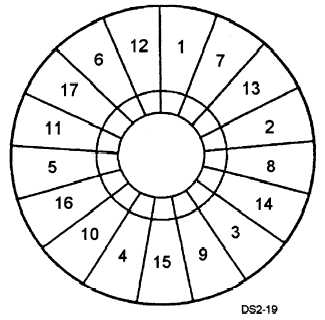Figure 10-19.—A 3:1 disk interleave.
the head. When the controller is ready for the data from
sector 2, the disk is approaching logical sector 2. In this
way, interleaving speeds up data retrieval and transfer.
Today many fixed disk controllers are fast enough to
handle a 1:1 interleave.
FIXED DISK INTERFACES
The last area of a fixed disk system is the type of
interface used to transfer data between the computer and
the disk. Several drive interfaces are in use today:
l ST-506/412
l IDE
l EIDE
l ESDI
l SCSI
ST-506/412 Interface
The ST-506/412 Interface was one of the first fixed
drive interfaces designed and became a standard for
many fixed disk systems. It was originally designed for
a 5M drive. As manufacturers improved the perform-
ance of their drives, a need developed to tell the com-
puter about the characteristics of the drive as far as how
many disks and heads are in the drive. This was accom-
plished by installing a drive table in the computer’s
BIOS ROM, and then having the technician tell the
computer what fixed disk system was being used by
running the set-up program. The original ST-506/412
specification dictated that modified frequency
modulation be used as the encoding scheme, but lately
the interface has been upgraded to include RLL 2,7.
The ST-506/412 interface also requires the data
encoder/decoder be on the disk controller. This means
that raw data is transferred from the disk to the
controller over the data cables. To reduce the
possibility of data loss during this transfer, fixed disk
data cables are kept as short as possible.
Enhanced Small Device Interface (ESDI)
The Enhanced Small Device Interface (ESDI) is a
high performance, high-speed interface and controller.
ESDI controllers increase reliability by putting the data
encoder/decoder circuitry on the drive logic board.
This eliminates the data errors caused by noise and
signal loss in the cables. ESDI is capable of transferring
data at a rate of 24 megabits per second. Most ESDI
drives today are limited to 10 or 15 megabits per second
due to limitations of the host computer’s I/O bus.
ESDI drives are capable of being formatted to 60
sectors per track or higher, although 32 sectors per track
is most common. All ESDI controllers can support a
1:1 interleave.
One of the most important features of ESDI systems
is that the controller can read the drive parameters
directly off the disk. With this capability, the controller
can tell the BIOS the type of drive installed. This
eliminates the need for the user to run the setup
program. Also, this feature allows for defect mapping,
further improving the drive’s reliability.
Integrated Drive Electronics (IDE)
The Integrated Drive Electronics (IDE) interface
was originally developed as an interface for hard cards.
A hard card is a small drive mounted on a controller
board which plugs directly into the personal computer’s
expansion slot.
IDE has been expanded to include
5.25-inch and 3.5-inch fixed disk systems. IDE drives
connect to the motherboard of the host computer with
a 40-pin connector.
IDE drives have much of the controller and
interface circuitry on the drive logic card. Recently,
computer manufacturers introduced motherboards with
IDE controllers and interfaces.
One major drawback of IDE drives is that you can
damage the drive if you try to perform a low-level
format on the drive.
10-27


